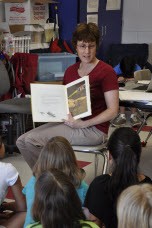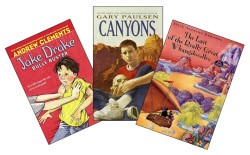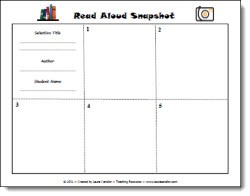Do you read aloud to your students every day? If not, you may be missing out on a wonderful opportunity to connect with your students and sneak in a little instruction at the same time! I always love reading aloud to my students and I know they enjoy that time as well. Reading aloud is not just for little ones. As you can tell from the picture of me reading to my 5th graders, even older kids like to gather around for a good story!I hope you’ll find the resources on this page helpful! The page is a work in progress and I’ll be adding more information and resources soon. My next step is to continue to add to the list of favorite read alouds. I have so many that it’s going to be difficult to list them all!
~ Laura Candler
Why Read Aloud?

Reading aloud is more than fun – it’s an effective teaching strategy. If you need convincing, consider the following benefits of reading aloud:
- Provides an opportunity to share your favorite stories, novels, and poems with the whole class
- During Reading Workshop, allows you to teach strategy mini lessons to the whole class since everyone is listening to the same selection
- Models fluent reading for students
- Introduces students to vivid and specific vocabulary
- Provides a chance to address important themes like friendship, courage, prejudice, bullying, etc.
- Offers a chance to use questioning strategies to explore concepts in the selection (making inferences, evaluating, etc.)
- Introduces kids to a variety of literary genres and authors
Tips for Reading Aloud
- Preview books to decide if they are suitable for the lesson and for your students. Some books just aren’t appropriate for some students despite the grade level recommendations on the cover or in book reviews.
- As you preview each book, mark passages in the book that may work for “think alouds” or reading strategy lessons.
- If you have a document camera, place your book under it so your students can follow the words while you are reading. It’s great for introducing new vocabulary and using context clues to infer meanings of new words.
- Choose books that you enjoy rather than reading something that was recommended to you. If you don’t like a book, you won’t be able to convince your students that you enjoy it.
- Since mini-lessons need to be kept short in length, you may want to read the book over several days or use a short non-fiction article
- If prior knowledge of specific concepts is necessary for understanding, introduce those ideas before reading the book or article. Use Google maps to show locations or historical images to recreate times and places.
- Read aloud with expression and enthusiasm! Don’t be afraid that you will sound silly by reading the story dramatically. Your students will love it!
- Read aloud nonfiction as well as fiction. Kid-friendly newspaper or magazine articles will spark discussion and add another dimension to your read aloud sessions.
Favorite Read Aloud Books

What makes a great read aloud for the upper elementary grades? To me, the best books challenge your students’ thinking. Some of my favorites have introduced a sensitive but important topic like prejudice or bullying, and they’ve opened opportunities to explore and discuss those issues. Other books have stimulate my students’ imagination or helped them explore historical events in meaningful ways. I’ve listed some of my favorite below, and you can read many more suggestions from other teachers on my Facebook question on this topic.
|
|
Canyons by Gary Paulsen
Recommended for 5th grade and upCanyons is a riveting story of a young man in modern times who becomes connected with a spirit from the past after he finds a skull on a camping trip. Great for connecting American history. Your students will love the dramatic ending!
~ Recommended by Laura Candler |
|
|
The Last of the Really Great Whangdoodles
by Julie Andrews ~ Recommended for 4th grade and upWonderful fantasy story about three children who meet a wacky professor and go in search of the mysterious, long-lost Whangdoodle. Along the way, they meet a collection of unusual characters and have excting adventures. Love the playful use of language in this book!
~ Recommended by Laura Candler |
|
|
Jake Drake, Bully Buster
by Andrew Clements ~ Recommended for 2nd grade and upJake has been bullied since before he started school, and now he’s been assigned to work with a Link Baxter, the new “super bully” in his class. However, as he works with Link, he learns a lot about himself and about how to “bust” a bully.
~ Recommended by Laura Candler |
More Great Read Aloud Books
- Thank You, Mr. Falker (Patricia Polacco)
- Running Out of Time (Margaret Peterson Haddix)
- Maniac Magee (Jerry Spinelli)
Read Aloud Activities and Strategies
Sometimes it’s fun to simply read aloud for enjoyment, but often teachers use their read aloud time as a basis for mini lessons or other reading instruction. Most files referenced in this section are in PDF format, so you’ll need Adobe Acrobat Reader view and print the files. If you have problems, please read the Helpful Hints on the Adobe Acrobat Reader Help page.

- Create a Character Word Cloud – Have students create a Character Word Cloud based on an important character in the read aloud. This activity requires an internet connection and the use of a website for creating “word clouds.” See example at right. You can try www.wordle.net, www.taxgedo.com, or www.abcya.com. Students will choose character traits for a given character and will create word clouds in which larger words represent the character traits that best represent the character. Complete directions are included on the Character Word Cloud file for teachers, but you need to try this activity yourself before using it with students. Decide which website you want to use and practice because each website operates a little differently. If you want to be able to type directly on the PDF file, you can download a variation of the above activity that includes PDF form fields. Note: For a complete character trait lesson, take a look at my Analyzing Character Traits Mini Pack. You’ll find 21 pages of ready-to-use lesson plans and printables.Need More Info? Here’s a slidecast presentation I created with step-by-step directions for how to create a Character Word Cloud. If the images are too small, you can open it full screen for better viewing.
- Character Voices – If appropriate, let student volunteers read aloud the character parts. For this strategy, you’ll need multiple copies of the same read-aloud book. Choose one student for each main character and tell them which pages you plan to read. Allow them a few minutes to review their parts, and then read the selection aloud to the class. You will read all the narration, but when it’s time for a character to speak, he or she will stand up and do so with expression.
- Multiple Readings of the Same Book – Consider using the same short book several times for different mini-lessons. Read the book aloud one time for enjoyment. The next time you read it, use it for a mini-lesson such as character development. Then read the book later in the year and use it for a different skill or strategy. Because students are familiar with the book, they can focus on how the skill or strategy applies to the story.
- Doodling and Drawing – Many students like to doodle or draw while they are listening and it actually keeps them from getting restless. However, some students become so involved with their drawings that they stop listening! My rule is that if I’m reading aloud and you are drawing, you need to be able to answer questions when I call on you. If you can’t respond because you don’t know what’s going on, you have just lost your drawing privileges.

 Read Aloud Snapshots – Do you sometimes wonder if your students are listening or just daydreaming? A strategy that works well for accountability is to have students draw a “snapshot” of the main idea for each day’s read-aloud session. On Monday, give each student a piece of paper to fold into sixths or use the Read Aloud Snapshot printable. In the first block, have them write the title of the book and their name. Each day after you read aloud, give them time to illustrate the main event or a key point from the reading. Students who don’t like to draw can write a snapshot (summary) instead. At the end of the week, all of the blocks will have been filled if you read every day. This makes a quick and easy assessment!
Read Aloud Snapshots – Do you sometimes wonder if your students are listening or just daydreaming? A strategy that works well for accountability is to have students draw a “snapshot” of the main idea for each day’s read-aloud session. On Monday, give each student a piece of paper to fold into sixths or use the Read Aloud Snapshot printable. In the first block, have them write the title of the book and their name. Each day after you read aloud, give them time to illustrate the main event or a key point from the reading. Students who don’t like to draw can write a snapshot (summary) instead. At the end of the week, all of the blocks will have been filled if you read every day. This makes a quick and easy assessment!
Candler’s Classroom Connections
Awesome freebies and resources for elementary educators!
Literacy Featured Products




 Read Aloud Snapshots – Do you sometimes wonder if your students are listening or just daydreaming? A strategy that works well for accountability is to have students draw a “snapshot” of the main idea for each day’s read-aloud session. On Monday, give each student a piece of paper to fold into sixths or use the Read Aloud Snapshot printable. In the first block, have them write the title of the book and their name. Each day after you read aloud, give them time to illustrate the main event or a key point from the reading. Students who don’t like to draw can write a snapshot (summary) instead. At the end of the week, all of the blocks will have been filled if you read every day. This makes a quick and easy assessment!
Read Aloud Snapshots – Do you sometimes wonder if your students are listening or just daydreaming? A strategy that works well for accountability is to have students draw a “snapshot” of the main idea for each day’s read-aloud session. On Monday, give each student a piece of paper to fold into sixths or use the Read Aloud Snapshot printable. In the first block, have them write the title of the book and their name. Each day after you read aloud, give them time to illustrate the main event or a key point from the reading. Students who don’t like to draw can write a snapshot (summary) instead. At the end of the week, all of the blocks will have been filled if you read every day. This makes a quick and easy assessment!